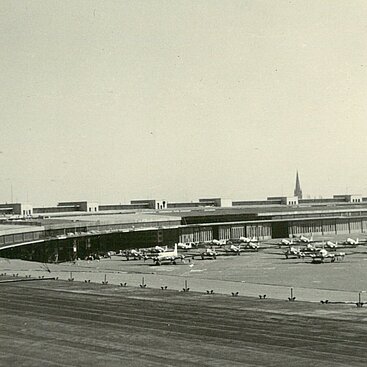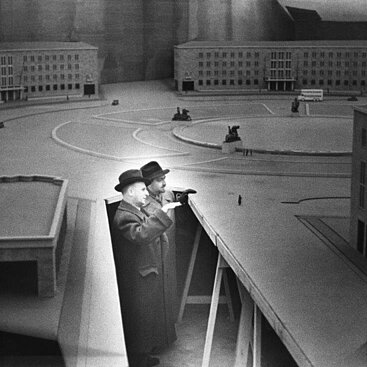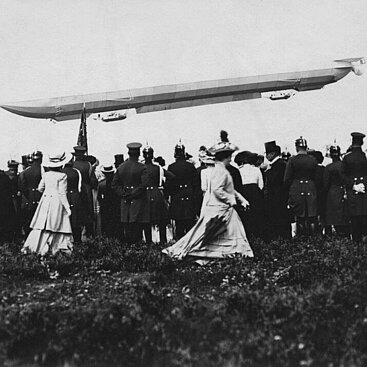Airlift
The blockade of West Berlin by the Soviet Union was the first highlight of the Cold War. The Western Allies responded to the blockage of their land and waterways to Berlin with an airlift for supplying the population in west sectors of Berlin. Thus the Western Allies showed their determination to enter into Berlin for freedom and democracy.
Marshall plan, currency reform and blockade
The history began in 1947 with Marshall plan, the US reconstruction aid for war-damaged Europe. USA wanted to provide raw materials, goods and capital as economic aid to help the people - expressly also for German occupation zones, East Central European countries and USSR. It refused the aid programme linked with political demands for its sphere of influence. Thus decisions were taken that deepened the division of Germany by binding the Soviet zone economically to the USSR while the American, British and French zone gained a clear prospects of the foundation of a common western state.
Prerequisite for the Marshall Plan aid was currency reform from the perspective of USA. On 20 June 1948, currency exchange began in the western zones; on 23 June, reform in West Berlin expanded. The Soviet Union responded with a blockade; on the night of 24 June 1948, Soviet troops blocked all the access roads to West Berlin. The gas and power supply from Soviet sector was disconnected. Factories, public facilities and households, even the garrisons of the Allied forces in the west sectors were no longer sufficiently supplied. The Western forces decided to defend their rights in Berlin. At the initiative of the US military governor Lucius D. Clay, “Operation Vittles”, the supply to western sectors of Berlin via air, began on 26 June with the landing of a Douglas C-47 “Skytrain” in Tempelhof.
Operation “Vittles” and “Plainfare”
Between 26 June 1948 and 6 October 1949, with almost 278,000 flights, more than 2.3 million tons of freight was transported: Food, coal, machines, equipment and other goods of daily need for the supply of 2.1 million people in West-Berlin. Despite the enormous quantity, the food and fuel rations were marginal. They could be increased within the scope of the low border traffic thanks to the help of relatives, friends and colleagues in East Berlin. After 11 May 1949, the day on which the Soviet Union lifted the blockade around midnight, airlift was continued with up to 1000 landings per day in order to fill the storage warehouse in case of further hindrances in accessing Berlin.
On 28 June 1948, even the British Army included their relief flights under the name “Operation Plainfare”. Every two to three minutes, an aircraft now landed on one of the three West Berlin airports. Tempelhof in the American sector was the main airport for the airlift. Together with the Gatow airfield, majority of all flights were operated here. The Tegel airport in the French sector, opened on 1 December 1948, ranked number three.
The aircrafts used the northern and southern air corridor in the direction of Hamburg and Frankfurt am Main for outbound flights and the north and south route from the direction of Hamburg and Hannover to Berlin for the return flight. Different flight attitudes were determined for different types of aircrafts, which flew with different speeds. If pilots were unable to immediately succeed in landing in Berlin, they had to fly back fully loaded because the cycle of take-offs and landings could not be differently complied with.
Even passenger transport in west zones was no longer functioning. 240000 people departed from or reached West-Berlin by plane. These included 5536 Jewish “Displaced Persons”, who were brought from Tempelhof to Frankfurt am Main via the morning flight during the last week of July 1948. They were survivors of Nazi concentration and extermination camps and were found as refugees after the anti-Semite persecutions in Poland and the Soviet Union establishment in two American reception camps in Berlin. By the mid of September, American aircrafts flew another around 220 Displaced Persons from Tempelhof from the Wittenau camp in the French sector, which was also dissolved.
On the way to continuous duty
In the beginning, USA provided only a small fleet of 32 Douglas C-47 “Skytrain”, a two-motor relatively slow aircraft, which could bring in supplies via maximum 12 flights daily because food and relief goods were far from enough. USA began to add four-motor Douglas C-54 “Skymaster” to Douglas C-47. On 16 July, 110 aircrafts of the type Skytrain, 54 of the type Skymaster as well as around 100 British aircrafts were already being used. By autumn, C-47 were stopped and replaced by C-54.
There were shortages of personnel as well. To carry out flights according to the plan, shifts had to be drastically extended. Sorties of 36 hours and more were not rare. Pilots were trained and freight handlers were recruited from the Berlin population in USA. The number of flights and the volume of goods could be obtained daily from newspapers. New records were reached and reset when unloading and refuelling. The daily best decorated the fuselage.
On 12 August 1948, 707 flights brought 4,724 tons of freight; for the first time more than the intended 4,500 tons. On 18 February 1949, the millionth ton reached Berlin. On 26 February, 902 sorties catered 8,000 tons. “Easter Parade” was the highlight on 16 April 1949: Within 24 hours, 12,940 tons of freight was flown in 1398 flights; an aircraft landed every 63 seconds. On 2nd July, the two millionth ton was unloaded.
Construction of Airport Tempelhof
The structural condition of the runway and landing strip on Airport Tempelhof had not coped up with the burdens of continuous duty. The run was covered with interlocking perforated plates. The hooks cracked under the weight of the four-motor DC-54; the smooth plates jeopardised the air traffic during rains. On 8 July 1948, construction of a new runway and landing strip “Runway B” began to the south of the airfield. It got a compressed foundation made of bricks, which were obtained from bombed urban districts. The bitumen for asphalt surface and perforated plates for strengthening it arrived in Tempelhof by plane. Runway B was completed after a construction period of two months. In the meanwhile, on the north side, there was a third runway and landing strip, which became operational in November 1948.
In order to safely guide a large number of aircrafts through air corridors, a long distance radar was installed on the main building of the airport. The radar system, developed for American antiaircraft in the Second World War, enabled monitoring of air space within a radius of 100 km. In late autumn of 1948, Tempelhof also received complete lighting for operating in fog and dark.
Berlin population long since supported the American and English pilots although they had previously flown war assignments against the city. Now people came to Airport Tempelhof to see the “dive bombers”. The children would get especially excited as pilot Gail Halvorsen regularly dropped small parachutes full of candy. A total of 22 tons of candy was distributed to the children in Berlin during the airlift and was enjoyed by adults often enough.
Victims of airlift and remembrance
On 8th July 1948, the first casualty of airlift took place during a crash near Wiesbaden. Up to the end of the air program, 77 people - 41 British, 31 Americans and 5 Berliners had met with an accident. A monument should be erected in the memory of the victims of the blockade was already being discussed in West Berlin before the end of the airlift. A day before the cancellation of Soviet restrictions, on 11th May 1949, the senate and district committee meeting decided to name the place in front of the main entrance of the airport as “Platz der Luftbrücke” (place of airlift).
The airlift monument of Eduard Ludwig (1906-1960) was handed over to the public on 10 July 1950.
St. Endlich, M. Geyler-von Bernus, B. Rossié
Literature
Wolfgang Benz, mission of democracy. The foundation history of the Federal Republic and emergence of GDR 1945-1949, Berlin 2010
Matthias Heisig, Airlift to Tempelhof - hangers and airlift, in: District Office of Tempelhof, Berlin (editor), Landing on Tempelhof. 75 years of central airport – 50 years of airlift, exhibition catalogue, Berlin without date specification (1998)
District Office of Tempelhof, Berlin (editor), Landing on Tempelhof. 75 years of central airport – 50 years of airlift, exhibition catalogue, Berlin without date specification (1998)
Frank Schmitz, Airport Tempelhof. Berlin’s Gateway to the World, Berlin 1997
Air Lift Foundation (editor), 50 years of Air Lift Foundation 1959-2009, commemorative publication, Berlin 2009
Hans Przychowski, Airlifts to Berlin. The Allied air transport 1945-1990, Berlin 1996
Helmut Trotnow (editor), The Berlin Airlift. Event and Memory, Berlin 2010





